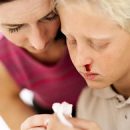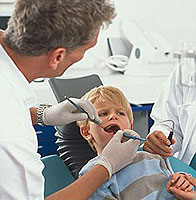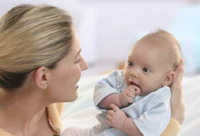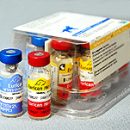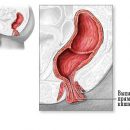What lies in the name of this disease and whether red is the main symptom of the disease? How is the disease of rubella, korea rubella and whether the rubella happens after vaccination? let's discuss.
Content
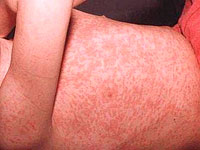 You, of course, heard about this acute infectious disease with such recognizable name, and whether you ever seen how it manifests itself and where it starts? Usually, with an increase in body temperature, cough and a cold, an increase in lymph nodes on the neck, pain in the joints and, of course, with the appearance of red rash on the skin, from here and its speaking name. Symptoms of the disease of rubella are quite rarely celebrated in adults, most often found in children under the age of 10. The causative agent of such a disease as rubella has a viral origin and is transmitted by air-droplet, getting on the mucous membrane of the nasopharynx of a healthy person. The virus can quietly live in the body of 21 days, without showing itself during the incubation period. The next, longitudinal period manifests the weak runny nose and cough, and at the same time a small pink-red rash appears, which disappears without a trace in a few days. The course of korea rubella most often passes asymptomatic and usually without the development of complications.
You, of course, heard about this acute infectious disease with such recognizable name, and whether you ever seen how it manifests itself and where it starts? Usually, with an increase in body temperature, cough and a cold, an increase in lymph nodes on the neck, pain in the joints and, of course, with the appearance of red rash on the skin, from here and its speaking name. Symptoms of the disease of rubella are quite rarely celebrated in adults, most often found in children under the age of 10. The causative agent of such a disease as rubella has a viral origin and is transmitted by air-droplet, getting on the mucous membrane of the nasopharynx of a healthy person. The virus can quietly live in the body of 21 days, without showing itself during the incubation period. The next, longitudinal period manifests the weak runny nose and cough, and at the same time a small pink-red rash appears, which disappears without a trace in a few days. The course of korea rubella most often passes asymptomatic and usually without the development of complications.
Cases of rubella after vaccination
In the development of individual immunological resistance, rare cases are described when rubella arises after vaccination, usually after 3-5 months. In this situation, unstable immunity is produced, and the level of immunoglobulins G is so low that it continues to steadily decline, then you can get sick again. Acute infection after vaccination, as well as rubella Koriw, are not severe diseases and are of serious danger only for pregnant women, what we will talk about below.
Danger in pregnancy
 As already noted, rubella disease is not heavy, but extremely dangerous for pregnant women. Involved intrauterine infection of the fetus, which in turn provokes the formation of congenital defects in newborns, a critical term — The first 3 months of pregnancy. The disease of a pregnant woman in a later date is fraught with the possibility of developing the fetus of Malokrovia, the defeat of the internal organs, the nervous system and Alzheimer's disease at a later age. And here, quite naturally, to the first plan to combat such a disease as rubella, preventive. Contacts should be avoided with patients with patients and infected, and in the case of forced contact, you need a mandatory study on the identification of anti-peasant antibodies in the blood. If in the course of diagnostics, the increase in antibodies time in the period of up to 18 weeks of pregnancy is detected — The abortion of pregnancy is not excluded due to the possibility of a child's birth with severe congenital pathology. The infectious disease of rubella, the prevention of which involves a number of events, including the vaccination of kids, starting from 12 months, requires a special vaccine that allows them to implement them together with the vaccinations against measles and vapotitis.
As already noted, rubella disease is not heavy, but extremely dangerous for pregnant women. Involved intrauterine infection of the fetus, which in turn provokes the formation of congenital defects in newborns, a critical term — The first 3 months of pregnancy. The disease of a pregnant woman in a later date is fraught with the possibility of developing the fetus of Malokrovia, the defeat of the internal organs, the nervous system and Alzheimer's disease at a later age. And here, quite naturally, to the first plan to combat such a disease as rubella, preventive. Contacts should be avoided with patients with patients and infected, and in the case of forced contact, you need a mandatory study on the identification of anti-peasant antibodies in the blood. If in the course of diagnostics, the increase in antibodies time in the period of up to 18 weeks of pregnancy is detected — The abortion of pregnancy is not excluded due to the possibility of a child's birth with severe congenital pathology. The infectious disease of rubella, the prevention of which involves a number of events, including the vaccination of kids, starting from 12 months, requires a special vaccine that allows them to implement them together with the vaccinations against measles and vapotitis.
Rubber treatment, prevention
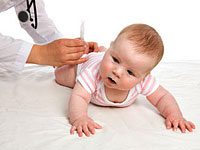 Preventive measures are also important in this infection, as well as other infectious diseases. Preventive events are shown both adults and children, and especially women and girls. Literate prevention of rubella and transferred Korean infectious rubella give a lifelong resistant immunity. Specific immune defense is developing 10-15 days after vaccination and remains for life. Vaccination of live vaccine creates immunity in 95-97% of the Cutchaev. It should be taken into account that it is necessary to avoid pregnancy after vaccination for 3 months, while the vaccination itself is not an indication for early interruption of pregnancy or cessation of breastfeeding.
Preventive measures are also important in this infection, as well as other infectious diseases. Preventive events are shown both adults and children, and especially women and girls. Literate prevention of rubella and transferred Korean infectious rubella give a lifelong resistant immunity. Specific immune defense is developing 10-15 days after vaccination and remains for life. Vaccination of live vaccine creates immunity in 95-97% of the Cutchaev. It should be taken into account that it is necessary to avoid pregnancy after vaccination for 3 months, while the vaccination itself is not an indication for early interruption of pregnancy or cessation of breastfeeding.
Treatment of this disease is usually carried out at home under the supervision of a physician with the mandatory and necessary volume of traditional drugs, as well as a milky-vegetable diet, enriched with vitamins, phytotherapy, with the necessary regular ventilation and wet cleaning. Admission to the body of vitamin C can be provided through various fruit and berry fruits, decoctions and films.


